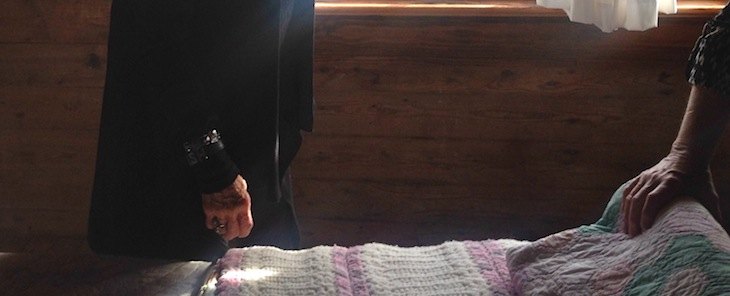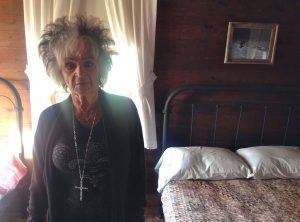Johnny Cash’s sister returns to their childhood home, takes visitors on ‘bittersweet’ tour
by October 23, 2017 5:04 pm 13,508 views

Joanne Cash, younger sister of Johnny Cash, touches a bed inside her childhood home in Dyess, Ark.
Long, barren row crop fields surround the tiny house that sits down a gravel road more than two miles long. A few tractors milled in the fields, as the sun peered through the clouds.
A Talk Business & Politics reporter decided on Friday (Oct. 20) to take a quick peek inside the house, the childhood home of musician Johnny Cash. A few red wasps buzzed around the edges. Security guards obliged the request. There was a tour guide and a couple of photographers milling inside the home.
Suddenly, a van appeared in the driveway. Several people, including a woman and a teacup Schnauzer climbed out of the van. The reporter petted the dog, and said hello to the woman.
“I’m Joanne Cash … I’m Johnny Cash’s sister,” she said.
Joanne Cash tenderly walked into the her family’s home place. The tour guide decided to take a break, and let Joanne tell her family story. As she entered the doorway, the first thing she noticed was the piano she used to play with her mother, Carrie. Often they played while Johnny sang she. As she spoke, she suddenly noticed the original floor linoleum, uncovered when the house was restored.
Above her was a quilting rack her mother would pull down to quilt. As she continued to turn, the shadows highlighted her face, her memories remained vivid. Sunlight cast through the windows was the only light in the house.
“It seems kind of small now. … Doesn’t this bring back the memories,” she said.
How the Cash family came to this desolate spot in rural Northeast Arkansas was a common story during a harsh bit of history. Drought, sporadic floods, and the Great Depression decimated family farms in the early 1930s. President Franklin Roosevelt started what was then called a socialistic plan to help many of these farmers in eastern Arkansas.
Ray and Carrie Cash brought their family to the Dyess Colony in 1935, according to historians. The Cashes moved to Dyess with their five children, Roy, 13; Louise, 11; Jack, 5; J. R., 3; and Reba, 1. Joanne and Tommy were born in Dyess.

During that era, the area was more swamp than usable farm ground. Workers drained the swamp and 500 farm families, including the Cash family received 40 acres and a mule through a federal government aid program. Rice and cotton were grown. Johnny Cash, along with his brother, Jack, worked the family farm and attended school. Work in the fields was grueling. At night, Johnny and Jack spent a lot of time in their room.
Their father, Ray was a strict disciplinarian who worked extremely hard, Joanne said. The children toiled in the cotton fields alongside their parents. Johnny, along with his siblings, was raised in humble circumstances and the Cash children were taught to work for what they earned, she said.
When Joanne walked back into the room in which Johnny slept, she smiled. Their brother, Tommy, and Johnny shared the same bed for several years. He joked about it often, she said.
“Tommy likes to tell people that he’s the only man who has ever slept with Johnny Cash,” she said to a chorus of laughter from those now following her through the house.
She stopped in her parents’ room. Two beds, one for the younger children and the parents have been erected. On her parent’s bed was her mother’s purse. Joanne donated the purse toward the project. One person asked her what Ray would think if he was here now.
“He’s in heaven. … I’m sure he’d rather go back to heaven than be here,” she said.
Arkansas State University Heritage Sites Director Dr. Ruth Hawkins told Talk Business & Politics Joanne and Tommy Cash were crucial to the restoration of the home. The siblings provided project leaders with every single detail of the home. ASU began restoration on the Cash childhood home in 2011. The dwelling was restored to its original condition, and an administrative building built into the old Colony theatre. The project cost about $3.5 million.
As Joanne made her way into the kitchen, her memories continued to swirl. She recalled her mother making bread on the stove. She canned all manner of fruits and vegetables. It was her mother, washing dishes one afternoon, who noticed something very different about Johnny. He always sang, but on this day the teenager’s voice seemed different. It had dropped, and when she heard her boy singing gospel songs in the yard that day, she knew he would be special.
In the bathroom, she took note of the humble living conditions. The house never had running water. A small pot sat on the floor where the toilet would have been located. The first 10 years they lived in the home, it didn’t have electricity.
A few tourists trickled into the house. Joanne walked into the main room, and mingled. A few wanted photographs, while others wanted autographs. Not far from where she stood is a mirror that depicts a video of Johnny Cash returning to the home many years after the family had left it. He recalled many vivid memories, and noted the charred marks on the floor caused by the wood stove.
Reliving the past is a mixed experience Joanne said as she exited the house and headed back to her van.
“Back then you couldn’t afford to buy stuff you had to make everything … being in the house is bittersweet,” she said.
